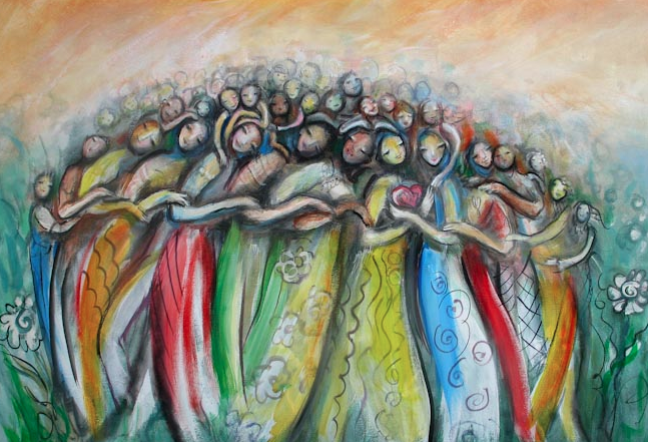“We are hardwired to connect with others, it’s what gives purpose and meaning to our lives, and without it there is suffering.”
– Brené Brown

The age old question – What is the Key to Well-Being? What is the Secret to Happiness?
Is it to be rich and famous? To have a successful career? To be admired and respected?
Why are some people happier than others? How can people learn to be happier? Is there a secret to happiness?
Prof. Sonja Lyubomirsky has spent her career exploring these concepts.
1) What makes people happy?
2) Is happiness a good thing?
3) How and why can people learn to lead happier and more flourishing lives?
Professor Lyubomirsky runs a Positive Psychology Lab at University of California, Riverside, and studies people who are happy. After hundreds of hours studying what makes people happy, she has compiled a list of the 6 major components leading to happiness:
- Be grateful – Gratitude evokes positive feelings
- Look on the bright side – optimism maintains a sunnier disposition. Lyubomirsky explains:
“My students and I have found that truly happy individuals construe life events and daily situations in ways that seem to maintain their happiness, while unhappy individuals construe experiences in ways that seem to reinforce unhappiness.”
- Savor the moment – Savoring positive moments offsets our negativity bias
- Exercise – Exercise releases chemicals that lead to positive feelings
- Meditate – Less stress, more happiness
- Cultivate Relationships – Positive Social Connections are considered by many as the most important factor in well-being.
First of all, what is positive social connection?
Brené Brown does it beautifully:
“I define connection as the energy that exists between people when they feel seen, heard, and valued; when they can give and receive without judgment; and when they derive sustenance and strength from the relationship.”

Recent research shows that people with good social connections are not only happier overall, but live longer than those with poor social connections.
The probability of dying early is 20% higher for obese people, 30% higher for excessive drinkers, 50% higher for smokers… but an incredible 70% higher for people with poor social relationships.
The need to connect socially with others is as basic as our need for food, water, and shelter.
So if positive social connection is so important, why is it that so many of us struggle with this?
Sharon Salzberg describes this struggle well:
Throughout our lives we long to love ourselves more deeply and to feel connected with others. Instead, we often contract, fear intimacy, and suffer a bewildering sense of separation. We crave love, and yet we are lonely. Our delusion of being separate from one another, of being apart from all that is around us, gives rise to all of this pain.
This contraction and fear that Salzberg describes can often be linked back to infancy, and even pre-natal trauma. In a wonderful interview, Diane Poole Heller explains how we are designed for connection but how experiences in infancy and childhood can cause disconnection. Heller describes the impact of Attachment Trauma and Developmental Trauma:
In terms of the original blueprint that we’ve received, attachment patterns can be described as an unconscious blueprint that is in our body memory.
The ideal patterning is Secure Attachment:
Secure Attachment would be a positive holding environment. That means that people around you are attuned to you. They get a sense of what your needs are. Really attuned parents can eventually understand a baby’s needs, but it’s hanging in there long enough with somebody to get to the real need. And often, good mothers just naturally do that. They just have a sense about it, or they learn it as they’re having an on-going relationship with their children. And most important, of course, in all of our life and all of our situations, it’s to show up and be present. For a Secure Attachment, there is this consistent responsiveness.
According to Heller, only 40% – 50% of us have Secure Attachment patterning. The rest of us however, must learn to overcome Insecure Attachment patterns: Ambivalent, Avoidant and Disorganized.
Very briefly –
- Avoidant patterning occurs in an environment that is highly neglectful – this Avoidant patterning can lead to a person disconnecting, dissociating and isolating.
- Ambivalent patterning occurs in an environment that is characterized by inconsistency – parents who are full-on at times and not available at all other times. It creates a lot of anxiety because there is no predictability. Ambivalent patterning can lead to a person becoming clingy and fearful.
- Disorganized patterning occurs when a child feels threatened, when a child feels a lot of fear and/or anger in response to the way a parent treats them. This often occurs when there is addiction, violence and chaos in a family. Disorganized patterning can lead to hyper-vigilance and/or immobilization and isolation.
(For a full description of these disorders, check out Diane Poole Heller’s website or read more about them in this article on Daily Good.)
Our lack of positive social connection can quite often be traced back to one of these patterning disorders. But there is hope. Heller describes models of trauma resolution and integrative healing techniques. She has even developed her own training series on adult attachment that she calls DARe, Dynamic Attachment Re-patterning experience which she describes in her new book called The Power of Attachment: How to Create Deep and Lasting Intimate Relationships.
Heller describes a simple exercise that can help with re-patterning. This practice originated with Patti Elledge’s Beam Gleam, Heller calls it her “Kind Eyes Exercise.”
Imagine that you’re looking out into the world, and there are kind, loving eyes looking back at you. This can be completely imaginary, or maybe you’ve seen a picture of the Dalai Lama looking beautifully compassionate, or even a picture from your history, one of your family members or your dog or a friend or even a stranger, but that has that “beam gleam” in their eyes that says, “I accept you. I care about you.” It’s kind of like in the olden days, when you used to surprise people at their homes, and drop something off, like a… I don’t know… banana nut bread or something. The person would open the door and go, “Oh my gosh! It’s you. Wow, I’m so glad you’re here,” and you just see them light up when they unexpectedly see you at their door. That would be a ‘beam gleam.’ That would be, you’re totally welcome. You feel completely loved by that person. You feel like they’re happy to see you, and that’s what we’re hoping to stimulate, just in eye contact.
That description is an example of a simple exercise to work on excavating old patterning and re-patterning Secure Attachment. Of course re-patterning takes time, commitment, energy, and usually a good therapist. But if this will lead to positive social connections, and if these connections are one of the main keys to well-being and possibly a longer life, isn’t it worth it?



